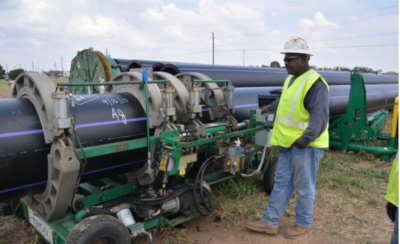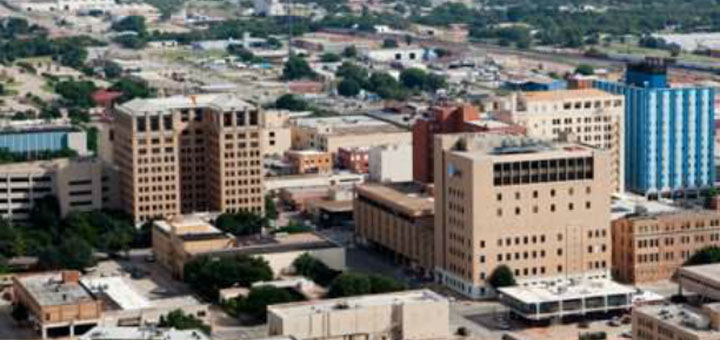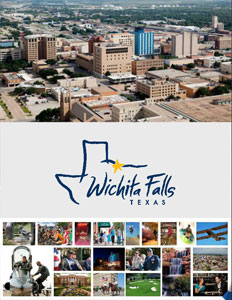Wichita Falls Texas
A city solves its water problems with characteristic resolve
Business View Magazine profiles Wichita Falls, Texas, a city of 104,000 located in North Texas, near the Oklahoma border.
From time to time every city has it problems. Sometimes they’re problems made by people, and sometimes they’re problems devised by Mother Nature. Sometimes a city’s problems are unsolvable and their repercussions, insurmountable. When that happens, a city can decline or even die. But when a city’s leaders and its people do come together to solve its problems, the city can get to live another day and possibly even grow both in size and stature. This is the story of how one city solved its problems head-on and became the better for it.
 Wichita Falls, a city of 104,000 in north Texas, about 15 miles south of the Oklahoma border, has certainly had its share of problems over the years – particularly of the Mother Nature type. The city was officially founded in 1872 and by 1886 a flood had already destroyed the original falls on the Wichita River, for which the city was named. (It was replaced some hundred years later by an artificial replica.)
Wichita Falls, a city of 104,000 in north Texas, about 15 miles south of the Oklahoma border, has certainly had its share of problems over the years – particularly of the Mother Nature type. The city was officially founded in 1872 and by 1886 a flood had already destroyed the original falls on the Wichita River, for which the city was named. (It was replaced some hundred years later by an artificial replica.)
In 1964, a devastating tornado ripped through the northwest portions of the city, destroying 225 homes, and damaging another 250. The F5 rated twister left seven dead and more than 100 injured. The damage was $15 million – $116 million in today’s dollars. Late one afternoon in 1979, another tornado struck the heavily populated southern sections of the city, and to this day, that particular April 10th is remembered as “Terrible Tuesday.” 42 people died and 1,800 were injured; 20,000 were left homeless. The bill was $400 million – $1.3 billion in today’s dollars.
Fortunately for Wichita Falls, those problems are in its past. They were solved by its people who applied their characteristic qualities of hard work, sacrifice, determination, and community spirit in order to persevere in the face of one of Mother Nature’s harsher incarnations. But In 2010, Mother Nature decided to strike again, though not this time as a violent tornado; this time she came in the form of a prolonged drought which left the city with a different problem to solve: how to supply its citizens with enough potable water from its severely depleted lakes.
Glenn Barham is the mayor of Wichita Falls. He was elected in 2010, just in time for the weather to get really hot. He tells the story of how the city confronted the problem of drought head-on, once again by applying its characteristic qualities of sacrifice, hard work, determination, and community spirit. “In 2011, Wichita Falls went through its worst summer in recorded history,” he begins. “We had over 100 days of 100 degree temperature; 50 consecutive days of 100 degree plus temperatures, which broke the old record of 35 consecutive days. Coupled with those high temperatures in 2011, we had our worst year in history of rainfall. We typically average 28+ inches of rain per year – that year, we had 13.5. 2012 wasn’t much better, though the temperatures moderated a little bit; we had 50 days of 100 degrees plus, but we also had another year of low rainfall – about 19 inches, which is two-thirds of what our normal average was. The last year of the drought, our water levels on our two primary lakes, Lake Arrowhead and Lake Kickapoo, averaged below 20 percent.”
Barham and the City Council decided there were two ways in which the problem could be most suitably addressed. One was conservation. Barham explains: “We were to the point where we did not allow any outside irrigation whatsoever. That lasted for about a year and a half. A lot of people lost trees, a lot of people lost their lawns; but we had to do it. Our average water use prior to the drought was about 35 million gallons a day; we’d see peaks as high as 52 or 53 million gallons and sometimes as low as 17 or 18 million, depending on the time of year, but the average ran about 35 million. Our average water use during the drought and during the restrictions was less than 11 million gallons a day. So our conservation efforts really paid off.”
But conservation, though important, was not enough. By 2012, it became apparent to Barham and his colleagues that another source of potable drinking water would have to be found. The city looked to its third remaining lake, Lake Kemp, for the answer. “Lake Arrowhead and Lake Kickapoo are two of the three water sources for the city,” he says. “We have a third source – Lake Kemp. In 2006, the city decided to build a microfiltration/reverse osmosis (MF/RO) plant in order to treat Lake Kemp water because Lake Kemp is very salty. So that brought on a third source of water, when that project went live in late 2008.”
 The city figured that if the MF/RO plant could be utilized to sanitize water other than what came out of Lake Kemp, for instance, wastewater that the city filtered at its wastewater plant some 13 miles away and routinely returned to the Wichita River where it flowed into the Red River, and finally into Lake Texoma, one of the largest lakes in the country, it could make up for the shortfall and provide enough clean and sanitary drinking water for the citizens of Wichita Falls.
The city figured that if the MF/RO plant could be utilized to sanitize water other than what came out of Lake Kemp, for instance, wastewater that the city filtered at its wastewater plant some 13 miles away and routinely returned to the Wichita River where it flowed into the Red River, and finally into Lake Texoma, one of the largest lakes in the country, it could make up for the shortfall and provide enough clean and sanitary drinking water for the citizens of Wichita Falls.
“We had some old plans that had been put on the shelf back in the early 2000s, when we went through a previous drought, but not nearly as bad as the drought of 2010-15,” says Barham. “At that time, the City Council considered using wastewater as another source of water. But the drought broke, so they shelved everything and forgot about it. We pulled those plans down; staff and our public works department started looking at them, and went to work in April 2012. We put a plan together and decided we needed to proceed with that program, so we contacted the Texas Commission on Environmental Quality (TCEQ), our regulatory agency, and after two years of wrangling with them and making sure they were comfortable with what we were proposing, we went live in July of 2014, treating our wastewater effluent.”
Now, Barham knew that “when you start using that type of water, you’re going to have a lot of public opinion issues.” So in order to assure the citizens that the treated wastewater from the MFRO plant was absolutely safe to drink, the city enlisted the aid of the Wichita County Medical Director, a local physician, and two professors from nearby Midwestern State University. “We took those folks on a tour of our wastewater plant; we took them over to our water treatment facility where the MFRO plant was; we showed them what we proposed to do and those four people put together, with our staff’s assistance, about a 30-minute program explaining in detail what the city was proposing and their thoughts and feelings about it. The four of them supported us on the project and we hired a public relations firm to help us. We didn’t want to make a big deal out of it, yet we wanted folks to be well aware that we were now using effluent water in our distribution system.”
With the plans in place, the city’s engineers and public works department went to work, building a 13-mile pipeline in order to get the treated wastewater from the wastewater plant over to the MF/RO plant located at the Cypress Water Treatment plant. “We laid that pipe above ground,” Barham says. “Fortunately, we had a flood control project that had been built in the early ‘80s that came to an end close to the wastewater plant, so we actually laid that pipe on the floor of that storm water runoff, called Holiday Creek, and then we went over ground, through some irrigation canals, under a couple of roads, and ultimately ran that pipeline to the MF/RO plant.”
The system, which is called a DPR, a Direct Potable Reuse System, was now capable of treating 5 million gallons a day to put back into the city’s water distribution system, while saving a concomitant 5 million gallons from having to be pulled from its increasingly thirsty lakes. Within seven months, the DPR produced one billion gallons of source water for the city. Problem solved.
And yet, if there’s any truth to the notion that the good Lord helps those who helps themselves, one can certainly point to Wichita Falls for confirmation. For Mother Nature had one more trick up her sleeve: exactly one year after the city turned on the DPR system, the drought ended. “We turned that project on in early July of 2014, and turned it off in July of 2015, after we had sufficient rain to bring our lakes back up.” During a three-week period in May, 17 inches of rain filled the city’s water source lakes which went from just below 19 percent to 100 percent capacity. Problem solved – again.
So, what will the city do with all the pipe it laid for the DPR system? According to Barham, the city’s intention, all along, was to build an IPR, an Indirect Potable Reuse System, where wastewater is not treated at a plant but returned to an area where it can be cleaned by nature. Because of the time frame to permit the project, design the improvements, and acquire the right-of-way, the DPR project was done as an emergency supply project, with the IPR being the long-term fix. “So, the reason we laid that pipeline above ground, was because we planned an IPR project after we came out of the drought,” he explains. “We wanted to save money on that project, so we built the pipeline above ground, and we purchased pipe that we sized to use in the IPR project. We’re going to use that pipe in our indirect project, saving us about six million dollars.”
And what if the city experiences another drought sometime in the future? Barham says that it will simply re-direct the water which it now pumps into Lake Texoma into its primary source, which is Lake Arrowhead, through a new pipeline which it is currently constructing, again, using some of the pipe that it used for the DPR project. “If it were up to me, I’d say ‘let’s bury that pipeline; let’s keep it here for emergencies. If we get into another drought situation in the future, we’ve got a means to fight it,’ But the engineers and water consultants tell us that during the seasons of low water use, like during the winter, we will actually see a rise in our lake level out at Lake Arrowhead of about ten to twelve million gallons a day. So, we will not build a permanent Direct Potable Reuse project because we think that our water supply, with the indirect project, will be sufficient to see us through another drought.”
 In addition, Barham says that another lake, Lake Ringgold, may be built about 20 miles east of town. “The permitting process will probably take us about eight to ten years to get through. So we’re starting that process to build that fourth water source lake. We have the rights to build that lake there and all the water that would be impounded in the lake. So, we’re going to proceed with the permitting and ten years from now, when the permits are approved, if we think there’s a need, then we’re going to proceed with building it.”
In addition, Barham says that another lake, Lake Ringgold, may be built about 20 miles east of town. “The permitting process will probably take us about eight to ten years to get through. So we’re starting that process to build that fourth water source lake. We have the rights to build that lake there and all the water that would be impounded in the lake. So, we’re going to proceed with the permitting and ten years from now, when the permits are approved, if we think there’s a need, then we’re going to proceed with building it.”
Now that the city has solved its water problems, both for the present and for the foreseeable future, Barham gives much credit to the citizens of Wichita Falls for their characteristic hard work, sacrifice, determination, and community spirit. “Our people in this community are second to none,” he declares. “If there’s a tragedy in this town, people come out of the woodwork to help. When somebody’s down in this community, there’s always somebody there to build ‘em back up. I can point to our conservation efforts during the drought. Our community took it to heart and understood what we were going through and what their part was in the whole process.” Barham pauses for a moment and then sums up his affection for the city he leads. “It’s just a downright, good place to live,” he says proudly.
Check out this handpicked feature on Elmhurst, Illinois – Close to everything, unlike anything.
AT A GLANCE
WHO: Wichita Falls, Texas
WHAT: A city of 104,000
WHERE: North Texas, near the Oklahoma border
WEBSITE: www.wichitafallstx.gov
PREFERRED VENDORS

Dailey-Wells Communications, Inc. – Dailey-Wells Communications (DWC) was founded in 1972, selling and servicing CB radios. In the late 1960s and early ‘70s, the company provided and maintained General Electric radio systems for public safety agencies such as the San Antonio Police Department. Today, DWC is a leading supplier of systems and equipment for the public safety, federal, utility, commercial, and transportation markets with products ranging from the most advanced IP voice and data networks, to industry leading multiband, multimode radios, to public safety-grade broadband video and data solutions. DWC supports over 500 systems around the world. – www.dwcomm.com
Intergraph Corporation – A software development and services company, the Intergraph Corporation provides enterprise engineering and geospatially-powered software to businesses, governments, and organizations. The company is headquartered in Huntsville, Alabama. It was founded in 1969 as M&S Computing, Inc., by former IBM engineers. It was renamed the Intergraph Corporation in 1980. In 2000, it exited the hardware business and became purely a software company. By 2008, it had become one of the hundred largest software companies in the world. It was acquired by Hexagon AB in 2010. – www.intergraph.com
DIG DIGITAL?





